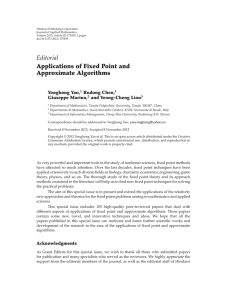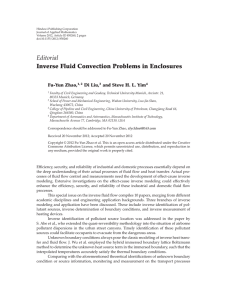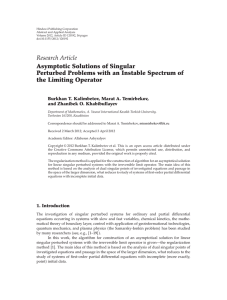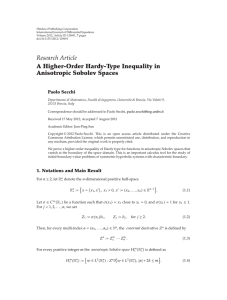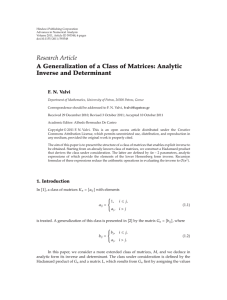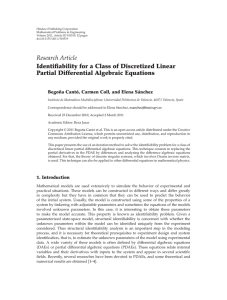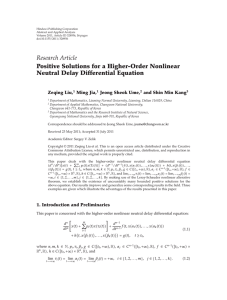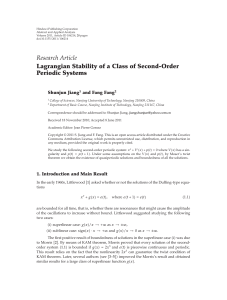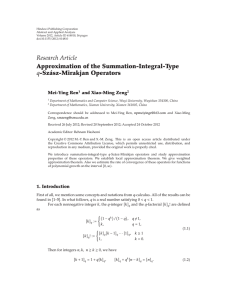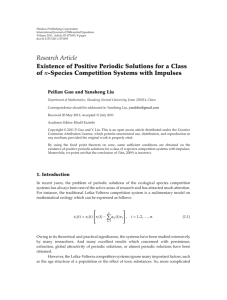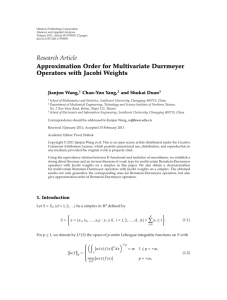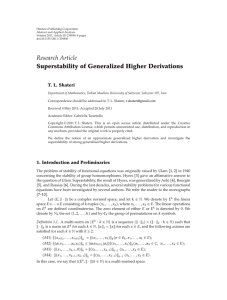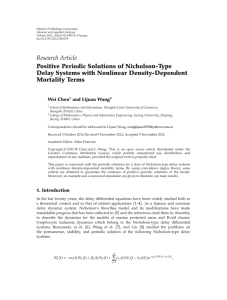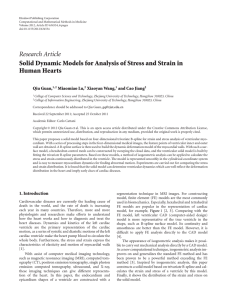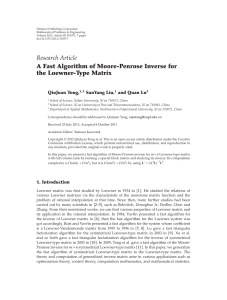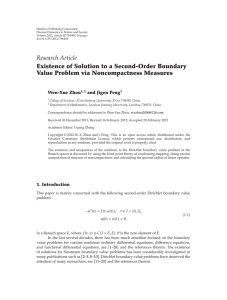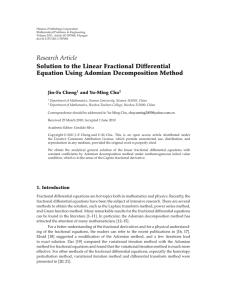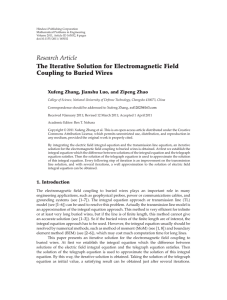Document 10824668
advertisement
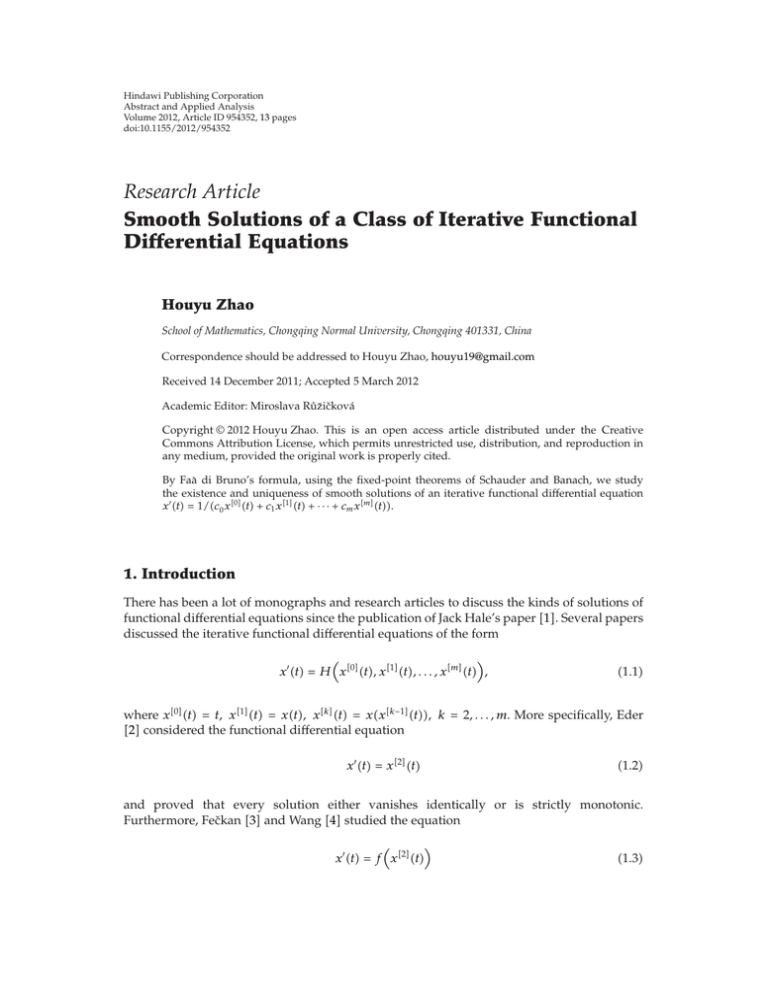
Hindawi Publishing Corporation
Abstract and Applied Analysis
Volume 2012, Article ID 954352, 13 pages
doi:10.1155/2012/954352
Research Article
Smooth Solutions of a Class of Iterative Functional
Differential Equations
Houyu Zhao
School of Mathematics, Chongqing Normal University, Chongqing 401331, China
Correspondence should be addressed to Houyu Zhao, houyu19@gmail.com
Received 14 December 2011; Accepted 5 March 2012
Academic Editor: Miroslava Růžičková
Copyright q 2012 Houyu Zhao. This is an open access article distributed under the Creative
Commons Attribution License, which permits unrestricted use, distribution, and reproduction in
any medium, provided the original work is properly cited.
By Faà di Bruno’s formula, using the fixed-point theorems of Schauder and Banach, we study
the existence and uniqueness of smooth solutions of an iterative functional differential equation
x t 1/c0 x0 t c1 x1 t · · · cm xm t.
1. Introduction
There has been a lot of monographs and research articles to discuss the kinds of solutions of
functional differential equations since the publication of Jack Hale’s paper 1. Several papers
discussed the iterative functional differential equations of the form
x t H x0 t, x1 t, . . . , xm t ,
1.1
where x0 t t, x1 t xt, xk t xxk−1 t, k 2, . . . , m. More specifically, Eder
2 considered the functional differential equation
x t x2 t
1.2
and proved that every solution either vanishes identically or is strictly monotonic.
Furthermore, Fečkan 3 and Wang 4 studied the equation
x t f x2 t
1.3
2
Abstract and Applied Analysis
with different conditions. Staněk 5 considered the equation
x t xt x2 t
1.4
and obtained every solution either vanishes identically or is strictly monotonic. Si and his
coauthors 6, 7 studied the following equations:
x t xm t,
1
x t m ,
x t
x t 1.5
1
c0
x0 t
c1
x1 t
· · · cm xm t
1.6
and established sufficient conditions for the existence of analytic solutions. Especially in 8,
9, the smooth solutions of the following equations:
x t m
aj xj t Ft,
j1
x t m
1.7
j
aj tx t Ft,
j1
have been studied by the fixed-point theorems of Schauder and Banach.
A smooth function is taken to mean one that has a number of continuous derivatives
and for which the highest continuous derivative is also Lipschitz. Let x ∈ Cn if x , . . . , xn are
continuous, Cn I, I is the set in which x ∈ Cn and maps a closed interval I into I. As in 9,
we, using the same symbols, denote the norm
xn n k x ,
k0
x max{|xt|},
t∈I
1.8
then Cn I, R with · n is a Banach space, and Cn I, I is a subset of Cn I, R. For given
Mi > 0 i 1, 2, . . . , n 1, let
ΩM1 , . . . , Mn1 ; I x ∈ Cn I, I : xi t ≤ Mi , i 1, 2, . . . , n;
n
x t1 − xn t2 ≤ Mn1 |t1 − t2 |, t, t1 , t2 ∈ I .
1.9
For convenience, we will make use of the notation
xij t xi xj t ,
k
x∗jk t xj t
,
1.10
Abstract and Applied Analysis
3
where i, j, and k are nonnegative integers. Let I be a closed interval in R. By induction, we
may prove that
x∗jk t Pjk x10 t, . . . , x1,j−1 t; . . . ; xk0 t, . . . , xk,j−1 t ,
⎛
⎞
j terms
j terms
⎜
⎟
k
k
⎟
βjk Pjk ⎜
⎝x ξ, . . . , x ξ; . . . ; x ξ, . . . , x ξ⎠,
Hjk
⎛ j terms
⎞
j terms
j terms
⎜
⎟
Pjk ⎝1, . . . , 1; M2 , . . . , M2 ; . . . ; Mk , . . . , Mk ⎠,
1.11
1.12
1.13
where Pjk is a uniquely defined multivariate polynomial with nonnegative coefficients. The
proof can be found in 8.
In order to seek a solution xt of 1.6, in Cn I, I such that ξ is a fixed point of the
function xt, that is, xξ ξ, it is natural to seek an interval I of the form ξ − δ, ξ δ with
δ > 0.
Let us define
Xξ; ξ0 , . . . , ξn ; 1, M2 , . . . , Mn1 ; I
x ∈ Ω1, M2 , . . . , Mn1 ; I : xξ ξ0 ξ, xi ξ ξi , i 1, 2, . . . , n .
1.14
2. Smooth Solutions of 1.6
In this section, we will prove the existence theorem of smooth solutions for 1.6. First of all,
we have the inequalities in the following for all xt, yt ∈ X:
j
x t1 − xj t2 ≤ |t1 − t2 |, t1 , t2 ∈ I, j 0, 1, . . . , m,
j
x − xj ≤ j x − y, j 1, . . . , m,
2.2
x − y ≤ δn xn − yn ,
2.3
2.1
and the proof can be found in 9.
Theorem 2.1. Let I ξ − δ, ξ δ, where ξ and δ satisfy
ξ≥
where |c0 | >
m
i0
|c0 | −
1
m
i1 |ci |
,
0<δ≤ξ−
|c0 | −
1
m
i1 |ci |
,
2.4
|ci |, then 1.6 has a solution in
Xξ; ξ0 , . . . , ξn ; 1, M2 , . . . , Mn1 ; I,
2.5
4
Abstract and Applied Analysis
provided the following conditions hold:
i
−1
m
ci
,
ξ1 ξ
−1
2.6
i0
−s−1 m
s1
m
−1s k − 1!s! i0 ci βi1
ξk ξ ci
s1 !s2 ! · · · sk−1 !
1!
i0
s2
sk−1
m
m
i0 ci βi2
i0 ci βik−1
×
···
,
2!
k − 1!
2.7
where k 2, . . . , n, and the sum is over all nonnegative integer solutions of the Diophantine equation
s1 2s2 · · · k − 1sk−1 k − 1 and s s1 s2 · · · sk−1 ,
ii
−s−1 m
s1
m
k − 1!s!
i0 |ci |Hi1
−s−1
ξ − δ
|c0 | − |ci |
s1 !s2 ! · · · sk−1 !
1!
i1
s2
sk−1
m
m
i0 |ci |Hi2
i0 |ci |Hik−1
×
···
≤ Mk , k 2, . . . , n,
2!
k − 1!
2.8
where s1 2s2 · · · k − 1sk−1 k − 1 and s s1 s2 · · · sk−1 ,
iii
n − 1!s!
s1 !s2 ! · · · sn−1 !1!s1 2!s2 · · · n − 1!sn−1
⎡
−s−2 s1 1 s2
m
m
m
−s−2
× ⎣s 1ξ − δ
|ci |Hi1
|ci |Hi2
|c0 | − |ci |
× ··· ×
×
m
m
i0
i1
sn−1
s1 ξ − δ−s−1
|ci |Hin−1
i0
i0
i1
s2 1 s3
sn−1
m
m
···
|ci |Hi2
|ci |Hi3
|ci |Hin−1
i0
· · · sn−1 ξ − δ
i0
i0
−s−1
|c0 | −
m
−s−1 m
i1
i0
|ci |
sn−1 −1 ⎤
m
m
×
|ci |Hin−1
|ci |Hin ⎦
i0
i0
−s−1 s1 −1
m
m
|ci |Hi1
|c0 | − |ci |
2.9
s1
|ci |Hi1
···
i0
≤ Mn1 ,
where s1 2s2 · · · n − 1sn−1 n − 1 and s s1 s2 · · · sn−1 ,
m
i0
sn−2
|ci |Hin−2
Abstract and Applied Analysis
5
Proof. Define an operator T from X into Cn I, I by
T xt ξ t
ξ
1
ds.
c0 x0 s c1 x1 s · · · cm xm s
2.10
We will prove that for any x ∈ X, T x ∈ X,
−1
m
t
1
ds ≤ ξ − δ |c0 | − |ci |
|t − ξ| ≤ δ,
|T xt − ξ| m
ξ i0 ci xi s i1
2.11
where the second inequality is from 2.4 and xI ⊆ I. Thus, T xI ⊆ I.
It is easy to see that
1
,
i
c
i0 i x t
T x t m
2.12
and by Faà di Bruno’s formula, for k 2, . . . , n, we have
k−1
m
s1
i
−1s k − 1!s!
1
1
i0 ci x t
t m
i
s1 !s2 ! · · · sk−1 ! m ci xi t
s1
1!
i0 ci x t
i0
⎞
⎛
m
s2
k−1 sk−1
m
i
i
i0 ci x t
i0 ci x t
⎠
⎝
×
···
2!
k − 1!
m
s1
−1s k − 1!s!
1
i0 ci x∗i1 t
s1 !s2 ! · · · sk−1 ! m ci xi t
s1
1!
i0
m
m
s2
sk−1
i0 ci x∗i2 t
i0 ci x∗ik−1 t
×
···
,
2!
k − 1!
2.13
k
T x
where the sum is over all nonnegative integer solutions of the Diophantine equation s1 2s2 · · · k − 1sk−1 k − 1 and s s1 s2 · · · sk−1 .
6
Abstract and Applied Analysis
Furthermore, note T xξ ξ, by 2.6 and 2.7,
1
1
ξ1 ,
m
i ξ
ξ
c
x
i0 ci
i0 i
s1
m
−1s k − 1!s!
1
i0 ci x∗i1 ξ
k
T x ξ s1 !s2 ! · · · sk−1 ! ξ m ci s1
1!
i0
s2
m
m
sk−1
i0 ci x∗i2 ξ
i0 ci x∗ik−1 ξ
×
···
2!
k − 1!
s1
m
−1s k − 1!s!
1
i0 ci βi1
s1 !s2 ! · · · sk−1 ! ξ m ci s1
1!
i0
s2
sk−1
m
m
i0 ci βi2
i0 ci βik−1
×
···
2!
k − 1!
ξk , k 2, . . . , n,
T x ξ m
2.14
where s1 2s2 · · · k − 1sk−1 k − 1 and s s1 s2 · · · sk−1 . Thus, T xk ξ ξk for
k 0, 1, . . . , n,
−1
m
1
T x t ≤ 1 M1 ,
≤ ξ − δ |c0 | − |ci |
i
m
i0 ci x t
i1
2.15
By 2.8, we have
s1
m
1
k − 1!s!
i0 |ci ||x∗i1 t|
s1 !s2 ! · · · sk−1 ! m ci xi ts1
1!
i0
s2
sk−1
m
m
i0 |ci ||x∗i2 t|
i0 |ci ||x∗ik−1 t|
×
···
2!
k − 1!
−s−1 m
s1
m
k − 1!s!
i0 |ci |Hi1
−s−1
≤
ξ − δ
|c0 | − |ci |
s1 !s2 ! · · · sk−1 !
1!
i1
m
m
s2
sk−1
i0 |ci |Hi2
i0 |ci |Hik−1
×
···
2!
k − 1!
≤ Mk , k 2, . . . , n,
T xk t ≤
where s1 2s2 · · · k − 1sk−1 k − 1 and s s1 s2 · · · sk−1 .
2.16
Abstract and Applied Analysis
7
Finally,
T xn t1 − T xn t2 n − 1!s!
≤
s1 !s2 ! · · · sn−1 !1!s1 2!s2 · · · n − 1!sn−1
−s−1 s1 s2
sn−1
m
m
m
m
i
×
ci x t1 ci x∗i1 t1 ci x∗i2 t1 ···
ci x∗in−1 t1 i0
i0
i0
i0
−s−1 s1 s2
sn−1 m
m
m
m
−
ci xi t2 ci x∗i1 t2 ci x∗i2 t2 ···
ci x∗in−1 t2 i0
i0
i0
i0
n − 1!s!
≤
s1 !s2 ! · · · sn−1 !1!s1 2!s2 · · · n − 1!sn−1
s 1
m
1
1
× |ci ||x∗i1 t1 |
s1 − m
s1 m
i
i
i0
i0 ci x t1 i0 ci x t2 sn−1 −s−1 m
m
× ···
ci xi t2 |ci ||x∗in−1 t1 |
i0
i0
s1 s1 s 2
m
m
m
×
ci x∗i1 t1 −
ci x∗i1 t2 ···
|c ||x t |
i0
i0 i ∗i2 1
i0
sn−1
−s−1 s 1
m
m
m
i
×
··· ci x t2 |ci ||x∗in−1 t1 |
|ci ||x∗i1 t2 |
i0
i0
i0
s 2
sn−2
m
m
×
···
|ci ||x∗i2 t2 |
|ci ||x∗in−2 t2 |
i0
i0
sn−1 sn−1 m
m
×
ci x∗in−1 t1 −
ci x∗in−1 t2 i0
i0
n − 1!s!
≤
s1 !s2 ! · · · sn−1 !1!s1 2!s2 · · · n − 1!sn−1
⎡
−s−2 s1 1 s2
m
m
m
−s−2
⎣
× s 1ξ − δ
|ci |Hi1
|ci |Hi2
|c0 | − |ci |
i0
i1
i0
−s−1 sn−1
s1 −1
m
m
m
−s−1
× ··· ×
s1 ξ − δ
|ci |Hin−1
|ci |Hi1
|c0 | − |ci |
i0
i0
i1
s2 1 s3
sn−1
m
m
m
×
···
|ci |Hi2
|ci |Hi3
|ci |Hin−1
i0
i0
i0
−s−1
· · · sn−1 ξ − δ
|c0 | −
m
−s−1 m
i1
i0
|ci |
sn−1 −1 ⎤
m
m
×
|ci |Hin−1
|ci |Hin ⎦|t1 − t2 |,
i0
s1
|ci |Hi1
···
m
sn−2
|ci |Hin−2
i0
i0
2.17
8
Abstract and Applied Analysis
where s1 2s2 · · · k − 1sk−1 k − 1 and s s1 s2 · · · sk−1 . By 2.9, we see that
T xn t1 − T xn t2 ≤ Mn1 |t1 − t2 |.
Now, we can say that T is an operator from X into itself.
Next, we will show that T is continuous. Let x, y ∈ X, then
n k k
T x − T y T x − T y x
x
−
T
y
−
Ty
T
T
n
k2
t
1
1
ds
max
−
m
m
i s
i s
t∈I ξ
c
x
c
y
i0 i
i0 i
1
1
max m
−
m
i
i
t∈I i0 ci x t
i0 ci y t
n
k − 1!s!
max
t∈I
s1 !s2 ! · · · sk−1 !1!s1 2!s2 · · · k − 1!sk−1
k2
1
× m
i0 ci x
×
m
i t s1
m
s1 s2
m
ci x∗i1 t
ci x∗i2 t
···
i0
i0
sk−1
1
− m
ci x∗ik−1 t
i0 ci y
i0
i t
s1
m
ci y∗i1 t
s1
s2
sk−1
m
m
×
ci y∗i2 t
···
ci y∗ik−1 t
i0
i0
i0
−2 m
m
i
i |ci |x − y |c0 | − |ci |
≤ δξ − δ−2
i1
i0
−2 m
m
i
i |ci |x − y |c0 | − |ci |
ξ − δ−2
i1
n
i0
k − 1!s!
t∈I
s1 !s2 ! · · · sk−1 !1!s1 2!s2 · · · k − 1!sk−1
k2
⎡
−s−1 −s−1 s1
m
m
m
i
i
× ⎣
ci x t
−
ci y t
···
|ci ||x∗i1 t|
i0
i0
i0
sk−1 −s−1 m
m
×
ci yi t
|ci ||x∗ik−1 t|
i0
i0
max
s1 s1 m
m
×
ci x∗i1 t
−
ci y∗i1 t
i0
i0
2.18
Abstract and Applied Analysis
s2
sk−1
m
m
×
···
|ci ||x∗i2 t|
|ci ||x∗ik−1 t|
i0
9
i0
−s−1 s
s
m
m
m
1
k−2
i
··· ci y t
···
|ci | y∗i1 t
|ci | y∗ik−2 t
i0
i0
i0
sk−1 sk−1 m
m
×
ci x∗ik−1 t
−
ci y∗ik−1 t
i0
i0
≤ ξ − δ
−2
|c0 | −
m
−2 |c0 | |ci |
i1
n k2
m
i|ci | x − y
i1
k − 1!s!
s1 !s2 ! · · · sk−1 !1!s1 2!s2 · · · k − 1!sk−1
⎡
× ⎣s 1ξ − δ
−s−2
m
|c0 | −
−s−2 m
i
i |ci |
|ci |x − y i0
i1
×
m
s1
···
|ci |Hi1
m
i0
sk−1
|ci |Hik−1
i0
s1 ξ − δ
−s−1
|c0 | −
m
−s−1 s1 −1
m
|ci |
|ci |Hi1
i0
i1
×
m
s2 1
|ci |Hi2
···
m
i0
|ci |Hik−1
sk−1 m
i0
i
i |ci |x − y i0
−s−1 s1
m
m
···
|ci |Hi1
|c0 | − |ci |
· · · sk−1 ξ − δ−s−1
i0
i1
×
m
sk−2 sk−1 −1 m
m
ci Hik
|ci |Hik−2
|ci |Hik−1
i0
×
m
i0
i0
i
i |ci |x − y i0
δ
n1
ξ − δ
−2
m
|c0 | − |ci |
i1
−2 m
|c0 | i|ci | xn − yn ,
i1
2.19
where s1 2s2 · · · k − 1sk−1 k − 1 and s s1 s2 · · · sk−1 .
10
Abstract and Applied Analysis
Moreover, we can find some constants Pk such that
n k − 1!s!
s1 s2
sk−1
s
!s
!
·
·
·
s
1 2
k−1 !1! 2! · · · k − 1!
k2
⎡
−s−2 m
m
i
−s−2
i ⎣
× s 1ξ − δ
|ci |x − y ×
|c0 | − |ci |
×
m
···
|ci |Hi1
i0
s1 ξ − δ
×
m
m
|c0 | −
···
|ci |Hi2
m
×
i0
sk−1 m
i
i |ci |Hik−1
|ci |x − y i0
2.20
i0
m
|c0 | − |ci |
−s−1 s1
m
···
|ci |Hi1
i0
i1
sk−2 sk−1 −1 m
m
ci Hik
|ci |Hik−2
|ci |Hik−1
i0
m
−s−1 s1 −1
m
|ci |
|ci |Hi1
m
· · · sk−1 ξ − δ−s−1
×
|ci |Hik−1
i1
s2 1
i0
m
sk−1
i0
−s−1
i0
i1
s1
i0
i0
i
i |ci |x − y i0
≤
n−1
Pk ξ, δ, ci , Hij xk − yk ,
k1
where
Pk ξ, δ, ci , Hij P ξ, δ; c1 , . . . , cm ; H11 , . . . , H1k1 ; . . . ; Hm1 , . . . , Hmk1 ; 2.21
are the positive constants depend on ξ, δ, ci , and Hij , i 1, . . . , m; j 1, . . . , k 1. Then
−2 m
m
T x − T y ≤ ξ − δ−2 |c0 | − |ci |
|c0 | i|ci | x − y
n
i1
n−1
Pk ξ, δ, ci , Hij xk − yk k1
δn1 ξ − δ−2 |c0 | −
≤ Γx − yn .
m
i1
i1
−2 |ci |
|c0 | m
i1
i|ci | xn − yn 2.22
Abstract and Applied Analysis
11
Here,
⎧
⎨
Γ max ξ − δ
⎩
−2
m
|c0 | − |ci |
δ
ξ − δ
−2
m
$ %
|c0 | i|ci | ; max Pk ξ, δ, ci , Hij ;
i1
n1
−2 |c0 | −
m
−2 |ci |
i1
1≤k≤n−1
i1
|c0 | m
i|ci |
i1
⎫
⎬
2.23
,
⎭
k 1, . . . , n − 1. So we can say that T is continuous.
It is easy to see that X is closed and convex. We now show that X is a relatively compact
subset of Cn I, I. For any x xt ∈ X,
xn ≤ x n n
k x ≤ |ξ| δ 1 Mk .
k1
2.24
k2
Next, for any t1 , t2 in I, we have
|xt1 − xt2 | ≤ |t1 − t2 |.
2.25
Hence, X is bounded in Cn I, I and equicontinuous on I, and by the Arzela-Ascoli theorem,
we know X is relatively compact in Cn I, I, since Cn I, I is the subset of Cn I, R, and we
can say that X is relatively compact in Cn I, R.
From Schauder’s fixed-point theorem, we conclude that
xt ξ t
ξ
1
ds,
c0 x0 s c1 x1 s · · · cm xm s
2.26
for some x xt in X. By differentiating both sides of the above equality, we see that x is the
desired solution of 1.6. This completes the proof.
Theorem 2.2. Let I ξ − δ, ξ δ, where ξ and δ satisfy 2.4, then 1.6 has a unique solution in
Xξ; ξ0 , . . . , ξn ; 1, M2 , . . . , Mn1 ; I,
2.27
provided the conditions 2.6–2.9 hold and Γ < 1 in 2.23.
Proof. Since Γ < 1, we see that T defined by 2.10 is contraction mapping on the close subset X
of Cn I, I. Thus, the fixed point x in the proof of Theorem 2.1 must be unique. This completes
the proof.
Remark 2.3. By Theorem 2.1 or Theorem 2.2, the existence and uniqueness of smooth solutions
of an iterative functional differential equation of the form 1.6 can be obtained. If n → ∞,
we can also find that the solution is C∞ -smooth.
12
Abstract and Applied Analysis
Now, we will show that the conditions in Theorem 2.1 do not self-contradict. Consider
the following equation:
x t 1
,
t 1/2xt 1/4xxt
2.28
where c0 1, c1 1/2, c2 1/4, and ξ ≥ 4. Moreover, we take 0 < δ ≤ ξ − 4. Then, 2.4
is satisfied, and ξ, δ define the interval I ξ − δ, ξ δ. Now, take ξ0 ξ,
4
ξ1 ξ−1 ,
7
16 −2
1 2
1
1 ξ1 ξ1 ,
ξ2 − ξ
49
2
4
2
4 −3
4
ξ 4 2ξ1 ξ12 − ξ−2 ξ2 2 ξ1 ξ12 ,
ξ3 343
49
2.29
then 2.6 and 2.7 are satisfied.
Finally, if we take
M1 1,
M2 28ξ − δ−2 ,
M3 392ξ − δ−3 16ξ − δ−2 M2
2.30
as positive, and
M4 8232ξ − δ−4 576ξ − δ−3 M2 8ξ − δ−2 6M22 5M3 ,
2.31
then 2.8 and 2.9 are satisfied.
Thus, we have shown that when ξ0 , . . . , ξ3 and M1 , . . . , M4 are defined as above, then
there will be a solution for 2.28 in Xξ; ξ0 , . . . , ξ3 ; 1, . . . , M4 ; I.
Acknowledgment
This work was partially supported by the Natural Science Foundation of Chongqing Normal
University Grant no. 12XLB003.
References
1 J. Hale, Theory of Functional Differential Equations, Springer, New York, NY, USA, 2nd edition, 1977.
2 E. Eder, “The functional-differential equation x t xxt,” Journal of Differential Equations, vol. 54,
no. 3, pp. 390–400, 1984.
3 M. Fečkan, “On a certain type of functional-differential equations,” Mathematica Slovaca, vol. 43, no. 1,
pp. 39–43, 1993.
4 K. Wang, “On the equation x t fxxt,” Funkcialaj Ekvacioj, vol. 33, no. 3, pp. 405–425, 1990.
5 S. Staněk, “On global properties of solutions of functional-differential equation x t xxt xt,”
Dynamic Systems and Applications, vol. 4, no. 2, pp. 263–277, 1995.
6 J.-G. Si, W.-R. Li, and S. S. Cheng, “Analytic solutions of an iterative functional-differential equation,”
Computers & Mathematics with Applications, vol. 33, no. 6, pp. 47–51, 1997.
Abstract and Applied Analysis
13
7 J. G. Si and W. N. Zhang, “Analytic solutions of a class of iterative functional differential equations,”
Journal of Computational and Applied Mathematics, vol. 162, no. 2, pp. 467–481, 2004.
8 J.-G. Si and S. S. Cheng, “Smooth solutions of a nonhomogeneous iterative functional-differential
equation,” Proceedings of the Royal Society of Edinburgh. Section A, vol. 128, no. 4, pp. 821–831, 1998.
9 J.-G. Si and X.-P. Wang, “Smooth solutions of a nonhomogeneous iterative functional-differential
equation with variable coefficients,” Journal of Mathematical Analysis and Applications, vol. 226, no. 2,
pp. 377–392, 1998.
Advances in
Operations Research
Hindawi Publishing Corporation
http://www.hindawi.com
Volume 2014
Advances in
Decision Sciences
Hindawi Publishing Corporation
http://www.hindawi.com
Volume 2014
Mathematical Problems
in Engineering
Hindawi Publishing Corporation
http://www.hindawi.com
Volume 2014
Journal of
Algebra
Hindawi Publishing Corporation
http://www.hindawi.com
Probability and Statistics
Volume 2014
The Scientific
World Journal
Hindawi Publishing Corporation
http://www.hindawi.com
Hindawi Publishing Corporation
http://www.hindawi.com
Volume 2014
International Journal of
Differential Equations
Hindawi Publishing Corporation
http://www.hindawi.com
Volume 2014
Volume 2014
Submit your manuscripts at
http://www.hindawi.com
International Journal of
Advances in
Combinatorics
Hindawi Publishing Corporation
http://www.hindawi.com
Mathematical Physics
Hindawi Publishing Corporation
http://www.hindawi.com
Volume 2014
Journal of
Complex Analysis
Hindawi Publishing Corporation
http://www.hindawi.com
Volume 2014
International
Journal of
Mathematics and
Mathematical
Sciences
Journal of
Hindawi Publishing Corporation
http://www.hindawi.com
Stochastic Analysis
Abstract and
Applied Analysis
Hindawi Publishing Corporation
http://www.hindawi.com
Hindawi Publishing Corporation
http://www.hindawi.com
International Journal of
Mathematics
Volume 2014
Volume 2014
Discrete Dynamics in
Nature and Society
Volume 2014
Volume 2014
Journal of
Journal of
Discrete Mathematics
Journal of
Volume 2014
Hindawi Publishing Corporation
http://www.hindawi.com
Applied Mathematics
Journal of
Function Spaces
Hindawi Publishing Corporation
http://www.hindawi.com
Volume 2014
Hindawi Publishing Corporation
http://www.hindawi.com
Volume 2014
Hindawi Publishing Corporation
http://www.hindawi.com
Volume 2014
Optimization
Hindawi Publishing Corporation
http://www.hindawi.com
Volume 2014
Hindawi Publishing Corporation
http://www.hindawi.com
Volume 2014

